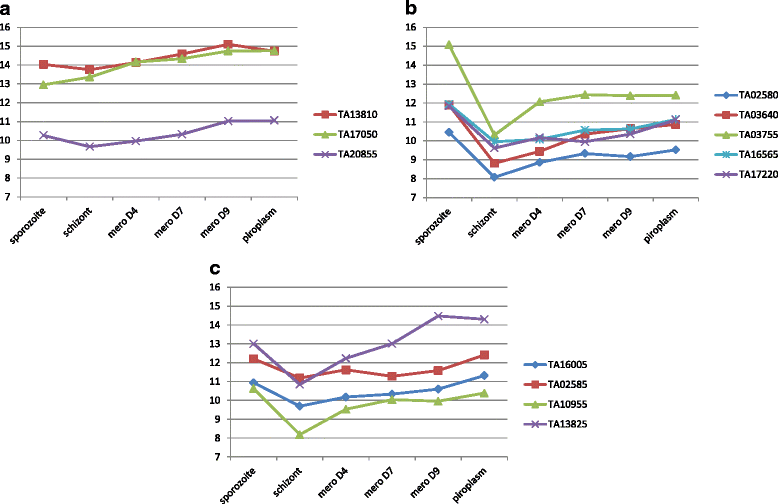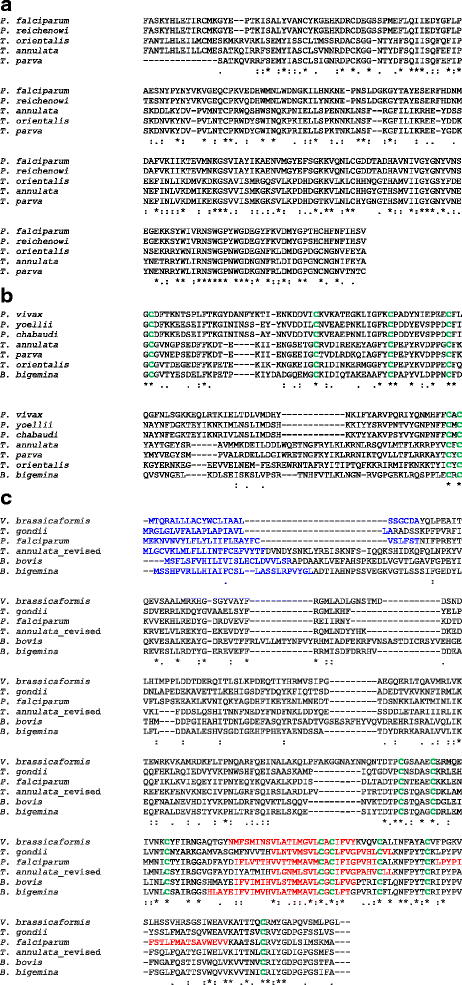Identification of candidate transmission-blocking antigen genes in Theileria annulata and related vector-borne apicomplexan parasites
- PMID: 28583072
- PMCID: PMC5460460
- DOI: 10.1186/s12864-017-3788-1
Identification of candidate transmission-blocking antigen genes in Theileria annulata and related vector-borne apicomplexan parasites
Abstract
Background: Vector-borne apicomplexan parasites are a major cause of mortality and morbidity to humans and livestock globally. The most important disease syndromes caused by these parasites are malaria, babesiosis and theileriosis. Strategies for control often target parasite stages in the mammalian host that cause disease, but this can result in reservoir infections that promote pathogen transmission and generate economic loss. Optimal control strategies should protect against clinical disease, block transmission and be applicable across related genera of parasites. We have used bioinformatics and transcriptomics to screen for transmission-blocking candidate antigens in the tick-borne apicomplexan parasite, Theileria annulata.
Results: A number of candidate antigen genes were identified which encoded amino acid domains that are conserved across vector-borne Apicomplexa (Babesia, Plasmodium and Theileria), including the Pfs48/45 6-cys domain and a novel cysteine-rich domain. Expression profiling confirmed that selected candidate genes are expressed by life cycle stages within infected ticks. Additionally, putative B cell epitopes were identified in the T. annulata gene sequences encoding the 6-cys and cysteine rich domains, in a gene encoding a putative papain-family cysteine peptidase, with similarity to the Plasmodium SERA family, and the gene encoding the T. annulata major merozoite/piroplasm surface antigen, Tams1.
Conclusions: Candidate genes were identified that encode proteins with similarity to known transmission blocking candidates in related parasites, while one is a novel candidate conserved across vector-borne apicomplexans and has a potential role in the sexual phase of the life cycle. The results indicate that a 'One Health' approach could be utilised to develop a transmission-blocking strategy effective against vector-borne apicomplexan parasites of animals and humans.
Keywords: 6-Cys domain; Babesia; Bioinformatic screen; Plasmodium; Theileria annulata; Transmission-blocking vaccine.
Figures




Similar articles
-
Immuno-informatics Analysis to Identify Novel Vaccine Candidates and Design of a Multi-Epitope Based Vaccine Candidate Against Theileria parasites.Front Immunol. 2018 Oct 15;9:2213. doi: 10.3389/fimmu.2018.02213. eCollection 2018. Front Immunol. 2018. PMID: 30374343 Free PMC article.
-
Molecular detection and genetic identification of Babesia bigemina, Theileria annulata, Theileria orientalis and Anaplasma marginale in Turkey.Ticks Tick Borne Dis. 2016 Feb;7(1):126-134. doi: 10.1016/j.ttbdis.2015.09.008. Epub 2015 Sep 28. Ticks Tick Borne Dis. 2016. PMID: 26492823
-
ApiAP2 Factors as Candidate Regulators of Stochastic Commitment to Merozoite Production in Theileria annulata.PLoS Negl Trop Dis. 2015 Aug 14;9(8):e0003933. doi: 10.1371/journal.pntd.0003933. eCollection 2015. PLoS Negl Trop Dis. 2015. PMID: 26273826 Free PMC article.
-
Current status of vaccine development against Theileria parasites.Parasitology. 2006;133 Suppl:S169-87. doi: 10.1017/S0031182006001867. Parasitology. 2006. PMID: 17274845 Review.
-
Directing differentiation in Theileria annulata: old methods and new possibilities for control of apicomplexan parasites.Int J Parasitol. 1998 Nov;28(11):1659-70. doi: 10.1016/s0020-7519(98)00131-3. Int J Parasitol. 1998. PMID: 9846602 Review.
Cited by
-
Comparative diagnostic performance of recombinant Tams1 protein based dot-ELISA in detecting tropical theileriosis in naturally infected cattle.Sci Rep. 2025 Jan 2;15(1):431. doi: 10.1038/s41598-024-84892-1. Sci Rep. 2025. PMID: 39748099 Free PMC article.
-
The Complexity of Piroplasms Life Cycles.Front Cell Infect Microbiol. 2018 Jul 23;8:248. doi: 10.3389/fcimb.2018.00248. eCollection 2018. Front Cell Infect Microbiol. 2018. PMID: 30083518 Free PMC article. Review.
-
Comparative Transcriptomics of the Bovine Apicomplexan Parasite Theileria parva Developmental Stages Reveals Massive Gene Expression Variation and Potential Vaccine Antigens.Front Vet Sci. 2020 Jun 9;7:287. doi: 10.3389/fvets.2020.00287. eCollection 2020. Front Vet Sci. 2020. PMID: 32582776 Free PMC article.
-
Plasmepsin-like Aspartyl Proteases in Babesia.Pathogens. 2021 Sep 26;10(10):1241. doi: 10.3390/pathogens10101241. Pathogens. 2021. PMID: 34684190 Free PMC article.
References
-
- Benelli G, Pavela R, Canale A, Mehlhorn H. Tick repellents and acaricides of botanical origin: a green roadmap to control tick-borne diseases? Parasitol Res. 2016;115:2545–60. - PubMed
Publication types
MeSH terms
Substances
Grants and funding
LinkOut - more resources
Full Text Sources
Other Literature Sources

